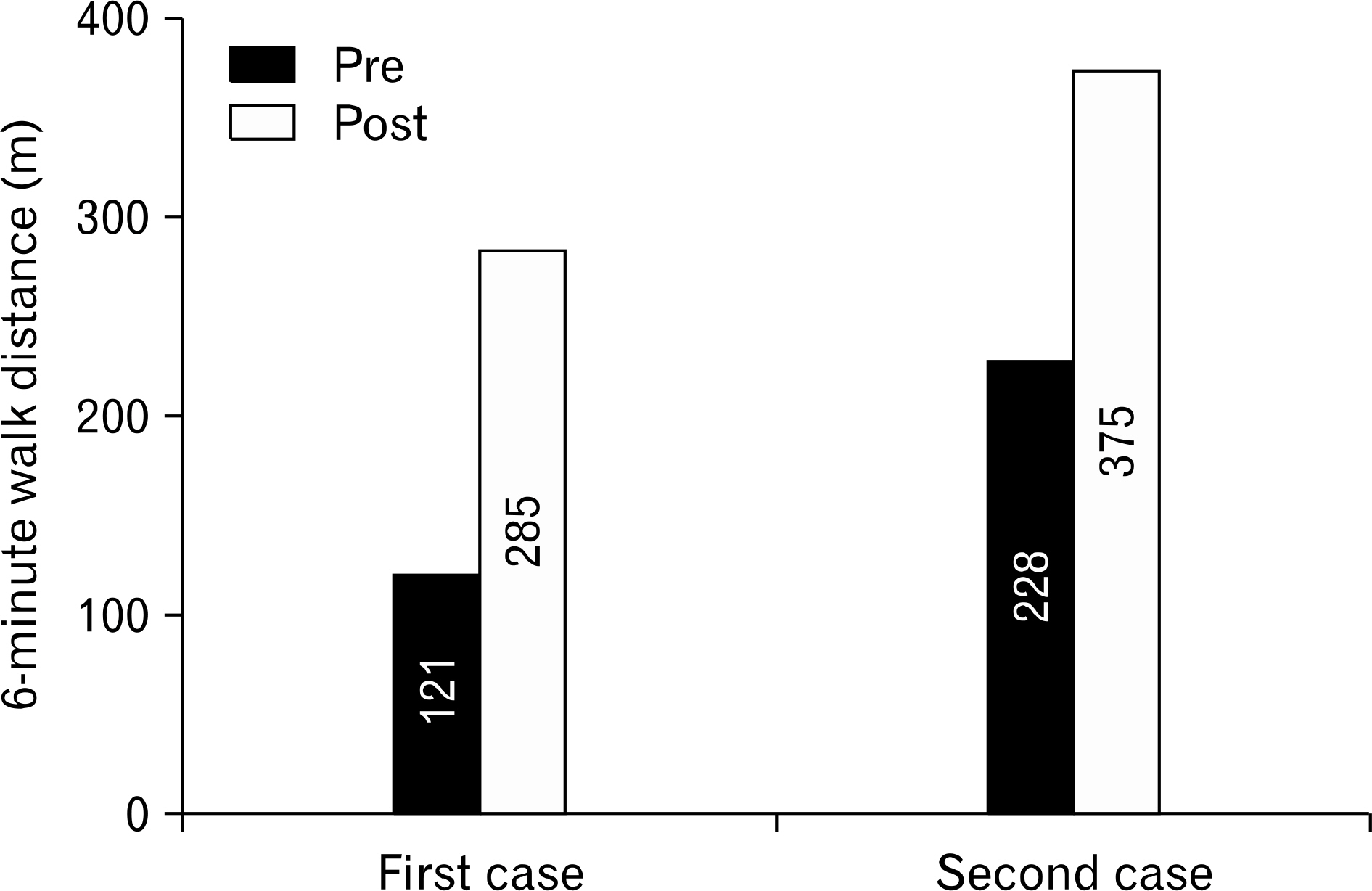Korean J Sports Med.
2016 Jun;34(1):78-82. 10.5763/kjsm.2016.34.1.78.
The Effect of Individualized Exercise Parameters Applied to Two Patients Recovering from Implanted Left Ventricular Assist Devices in Korea
- Affiliations
-
- 1Division of Sports Medicine, Department of Orthopedic Surgery, Samsung Medical Center, Sungkyunkwan University School of Medicine, Seoul, Korea. yongon79@naver.com
- 2Rehabilitation and Prevention Center, Division of Cardiology, Department of Medicine, Samsung Medical Center, Sungkyunkwan University School of Medicine, Seoul, Korea.
- KMID: 2361673
- DOI: http://doi.org/10.5763/kjsm.2016.34.1.78
Abstract
- Left ventricular assist devices (LVADs) are a treatment option for patients with severe chronic heart failure. These patients are referred to an inpatient cardiac rehabilitation after implantation to improve an aerobic capacity and quality of life (QOL). Several studies have reported that an exercise therapy, which is a component of cardiac rehabilitation, improves exercise capacity and QOL. The LVADs were implanted successfully in a destination therapy in two Korean patients, and these patients were enrolled in the cardiac rehabilitation. After an individualized intervention, they were discharged from improved exercise functional capacity and QOL. This is the first report showing a benefit of the individualized exercise therapy using different parameters after LVADs implantation in Korea.
MeSH Terms
Figure
Reference
-
1.Roger VL., Go AS., Lloyd-Jones DM, et al. Executive summary: heart disease and stroke statistics— 2012 update: a report from the American Heart Association. Circulation. 2012. 125:188–97.2.Ministry of Health and Welfare. Ministry of health and welfare statistical year book 2013 [Internet]. Sejong (KR): Ministry of Health and Welfare; [cited 2016 May 1]. Available from:. http://stat.mohw.go.kr/front/statData/mohwAnnalsWpView.jsp?menuId=14&bbsSeq=1&nttSeq=21132&nttClsCd=01&searchKey=&searchWord=&nPage=1.3.Slaughter MS., Rogers JG., Milano CA, et al. Advanced heart failure treated with continuous-flow left ventricular assist device. N Engl J Med. 2009. 361:2241–51.
Article4.Hayes K., Leet AS., Bradley SJ., Holland AE. Effects of exercise training on exercise capacity and quality of life in patients with a left ventricular assist device: a preliminary randomized controlled trial. J Heart Lung Transplant. 2012. 31:729–34.
Article5.Ueno A., Tomizawa Y. Cardiac rehabilitation and artificial heart devices. J Artif Organs. 2009. 12:90–7.
Article6.Scheiderer R., Belden C., Schwab D., Haney C., Paz J. Exercise guidelines for inpatients following ventricular assist device placement: a systematic review of the literature. Cardiopulm Phys Ther J. 2013. 24:35–42.
Article7.Maciver J., Ross HJ. Quality of life and left ventricular assist device support. Circulation. 2012. 126:866–74.
Article8.Wells CL. Physical therapist management of patients with ventricular assist devices: key considerations for the acute care physical therapist. Phys Ther. 2013. 93:266–78.
Article9.Ross RM., Murthy JN., Wollak ID., Jackson AS. The six minute walk test accurately estimates mean peak oxygen uptake. BMC Pulm Med. 2010. 10:31.
Article10.Kirklin JK., Naftel DC., Kormos RL, et al. Third INTERMACS Annual Report: the evolution of destination therapy in the United States. J Heart Lung Transplant. 2011. 30:115–23.
Article
- Full Text Links
- Actions
-
Cited
- CITED
-
- Close
- Share
- Similar articles
-
- Exercise Therapy for an Older Patient With Left Ventricular Assist Device
- Left Ventricular Assist Devices (LVADS): History, Clinical Application and Complications
- Central-Approach Surgical Repair of Coarctation of the Aorta with a Back-up Left Ventricular Assist Device for an Infant Presenting with Severe Left Ventricular Dysfunction
- Temporary Right Ventricular Assist Device Insertion via Left Thoracotomy after Left Ventricular Assist Device Implantation
- Driveline Infections Incidence According to Dressing Methods for Patients with Left Ventricular Assist Device Implantation




